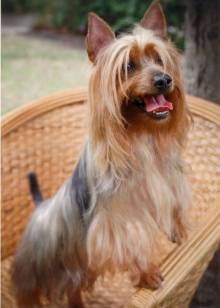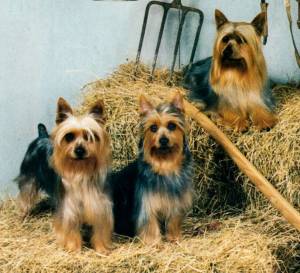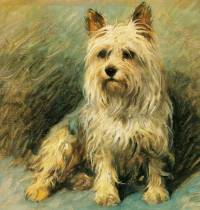Australian Silky Terrier
 Australian Silky Terrier
Australian Silky Terrier
Originally developed from a mixture between the Rough Coated Terrier, the Dandie Dinmont and Yorkshire Terrier, the Australian Silky Terrier began to evolve a century and a half ago. Later it became split again into two separate breeds and then split again, developing in two separate cities situated some 900 km apart. Such were the mix-ups that produced the only toy breed indigenous to Australia.
History of the Australian Silky Terrier
In 1896 it was reported:
 Australian Silky Terrier
Australian Silky Terrier
There is always some difficulty in deciding the awards for the popular small terrier which some people call the Australian Terrier which is, in reality neither Scotch, Skye or Yorkie but a well regulated mixture of these breeds eminently suitable for Australian climates and work.
Of these there are two distinct kinds, one more suitable for country and field work, while the other is specially adapted to become the pet of the children of the household.
These are differentiated particularly by their coats, which the former is required to be wire-haired, or broken haired i.e very coarse and thick, while in the case of the household pet, it is better to be silky and soft to touch, and above all, easy to be thoroughly washed and dried'[10].
One Breed Splits into Two
 Australian Silky Terriers
Australian Silky Terriers
In other words, by 1896 it had become evident that, in Australia two distinctly different types of coat had evolved on Rough Coated Terriers. As stated above, it seemed logical that these two breeds would become differentiated by their coat texture.
By the beginning of the 1900s with no Breed Standards to guide them, it was reported:
'... there seems to be no settled practice in making awards, for some judges disregarded the texture of the coat while others seem to consider it of the utmost importance, and send from the ring, as the case may be, either the rough or the silky contestants. The same dogs have met in the past under different judges, and with ludicrously varied results'.[10]
The two different breeds were to become:
1. The Australian Terrier
 Australian Terrier
Australian Terrier
The Australian Terrier which was produced when the rough haired coat of the Scotch was mixed with the coat of the Dandie Dinmont, a soft, silky topknot was produced on a rough coated terrier. The rough coat protected the terrier from the vermin it was required to hunt while the topknot and the associated ruff around his neck, protected the terrier by acting as a decoy for vermin, particularly snakes. This became the a breed that was particularly useful for field work. We still know it today as the Australian Terrier.
2. The Australian Silky Terrier
 Early Australian Silky Terrier
Early Australian Silky Terrier
The Australian Silky Terrier was produced when the coat of the rough coated terrier was softened by combining it with the soft, silky coat of the Yorkshire Terrier. This produced a breed with a coat that was easily washed and dried. This became the Australian Silky Terrier, the popular household pet we know today.
'A Tale of Two Cities'
 Australian Silky c 1900
Australian Silky c 1900
However confusingly, the Australian Silky Terrier we know today also evolved separately again in Sydney and Melbourne. These two cities are the capitals of two separately governed Australian States situated some 900 kilometres apart connected at that time, only by a rough gravel road. Hence, with two different Breed Standards, its development could well be called "A Tale of Two Cities".
One excellent description in 1912 was:
"Its sire was Australian; component parts were many -
Yorkshire, black and tan, and Scotch - it proved much worse than any.
Another dash of Yorkshire; the result was far more pretty;
They called it 'Sydney' Silky but quarrelled o'er the city"[4a]
Silky Terriers in Victoria
 Victorian Silky 1904
Victorian Silky 1904
In Melbourne, The first Breed Standard of 'the Silky Terrier' was approved by the Victorian Poultry and Kennel Club in 1904. Written by the Victorian Silky and Yorkshire Club, it followed the example set by the English Yorkshire Terrier Club. There were two weight divisions, those under 6 pounds and those from 6 and up to 12 pounds. Both pricked and dropped ears were allowable.
In 1909 the Victorian Silky and Yorkshire Club held its first Show. In 1912, when Tyzack's Annual was published by the Victorian Poultry and Kennel Club, it listed 22 Silky Terriers (Victorian) without designating the weight of any of them[4a]. These were simply called 'Silky Terriers' in Victorian Shows until 1958.
The 'Sydney Silky'
 Early Australian Silky Terriers
Early Australian Silky Terriers
Simultaneously in Sydney, New South Wales (NSW), in 1891 the Royal Agricultural Show had classes for 'Terrier, any other Variety'. From 1901-1906 the name of these classes was 'Terrier Soft and Silky'. When the NSW Breed Standard was set up by the Kennel Association around 1907, the breed was named 'Terrier, Sydney Silky'.
In contrast to Victoria's 'Silky Terrier', the Sydney Silky had only one allowable weight - from 6 to under 12 pounds. They also only allowed pricked ears[9]. In the 1930's the 'Sydney Silky' also made its identity known overseas, particularly in India where it resided with British diplomats[7].
The Australian Silky Terrier becomes a Pure Breed
 Silky Terrier Recognition Certificate 1949
Silky Terrier Recognition Certificate 1949
In Victoria until 1934, Silky Terriers was a bi-product of crossing Australian and Yorkshire Terriers. When this became prohibited, litters produced by this cross could still be registered if the pups were physically examined by two qualified judges. However, registration required a Certificate like accompanying one, to be presented to the Victorian Kennel Control Council (KCC).
In 1950 the Victorian Kennel Control Council (KCC) produced a Breed Standard for the Australian Silky Terrier encompassing all the salient features of both the NSW and Victorian Breed Standards. In March 1959 after the ANKC was formed, this revised Breed Standard was adopted and the breed name adopted. In every State, a panel of judges physically examined every pup from any crossed breed litters before registration as an Australian Silky Terrier could be accepted[2].
By 1972 the Australian Silky Terrier was taking its rightful place alongside other recognised ANKC breeds. This was demonstrated when Ch Dulcannina Kansas owned and bred by Mrs Sybil Camac of South Australia and handled by her son James, won Best Exhibit in Show at the Royal Melbourne Show, Australia's largest dog show at that time. Please click on the accompanying video clip.
Yorkshire and Australian Silky Terrier Comparison
The Yorkie is a neat compact spirited Toy Terrier, and although he conveys an important air, his straight silky distinctive coat is his most defining characteristic. In comparison, the Australian Silky Terrier should definitely display Terrier characteristics, embodying keen alertness, activity and soundness, appearing capable of killing vermin such as rats and mice.
| Yorkshire Terrier | Australian Silky Terrier | |
|---|---|---|
| Country of Origin | England | Australia |
| Size | Weight up to 7 pounds (3.2 kilos) with no specified height. | Dogs - Height 23 to 26 cms (9 to 10 ins) at the withers, bitches slightly less, weight proportionate. |
| Colour | The body coat from occiput to root of tail is dark steel blue (not silver blue), and should never be intermingled with fawn, bronze or dark hairs. The rich golden tan hair of the head is called a 'fall' because of its length about the ear roots and muzzle. | Any shade of blue and tan with a silver blue or fawn top-knot desirable. The blue body colour should be free from tan or bronzing while the tan markings must be free from smuttiness |
| Coat | The hair on the body is moderately long, glossy, perfectly straight, with a fine silky texture but never wavy or woolly. | The length of coat should be shorter than that of the Yorkie, allowing daylight to be seen underneath the dog. |
|
|
 Australian Silky Australian Silky |
|
| Head | The head is rather small with a flat skull, small erect ears and medium dark eyes that look straight ahead. | The strong head of the Silky is of moderate length in contrast to the rather smaller head of the Yorkie. |
| Ears | Small, V-shaped and erect, covered with short hair | Small V-shaped and erect but entirely free from hair |
| Mouth | Normal scissors bite | Normal scissors bite |
| Forequarters | Legs straight, well covered with hair of rich golden tan a few shades lighter at ends than at roots. | The straight forelegs have refined, round bone and are set well under the body with no weakness in the pasterns. |
| Feet | Round with black nails | Small and cat-like with black or very dark toenails |
| Body | Compact with level topline | Longer than its height at withers, with a level topline |
|
|
 Australian Silky Terrier Australian Silky Terrier |
|
| Hindquarters | The legs should be straight when viewed from behind with a moderate turn of stifle. They should be well covered with rich golden tan hair, a few shades lighter at ends than at roots. | The well developed thighs and well bent stifles should accompany well let down hocks that are parallel with each other. |
| Tail | Carried a little higher than the level of the back. | The tail should be free of feathering, set on high and carried erect but not over-gay. |
| Gait | Free with a straight action fore and aft | Free with drive from behind, retaining a level topline. |
References and Further Reading
[1] Rawdon B. Lee, "Modern Dogs (Terriers)" published by London: Horace Cox, "Field" Office, Windsor House, Bream's Buildings, E.C 1903. Pages 382 - 384
[2] W.A.(Fred) Wheatland, "The Australian Terrier and The Australian Silky Terrier", Published by The Hawthorn Press, Melbourne January 1964, Chapter 8 Pages 30 - 31.
[4] "Tyzack's Annual" Compiled by T.W.Tyzack and C.S. Turner published by the Victorian Poultry and Kennel Club 1912, printed by Bellmaine Bros., Printers 66 - 70 Flinders Lane Melbourne Australia. Yorkshire Terrier Importations P. 99 - 101
[4a] ibid., "Tyzack's Annual" Silky Terriers Stud Book Page P.75, Yorkshire Terriers Stud Book P. 75
[4c] ibid., "Tyzack's Annual" 'The Book of Chronicles' P 135
[5] 'The History of Purebred Dogs in Australia' published by OzDog Newspaper 1997 , Yorkshire Terrier by Bill Zaal Page 309
[7] Hutchinson's Dog Encyclopedia" Published by Hutchinson & Co. (Publishers) LTD., 34 - 36 Paternoster Row, London, E.C.4 1933, 'The Silky Terrier' Page Page 1801
[8] W. Beilby 'The Dog in Australasia' published George Robertson & Company in 1897 Chapter on Rough or Broken Coated Terriers Page 398
[9] W.A.(Fred) Wheatland 'The Australian Terrier' (and the) Australian Silky Terrier Self-Published 1964 Printed by the Hawthorn Press, Melbourne Chapter 9 'The Standard of The Australian Silky Terrier Pages 35 - 40
[10] 'Town and Country Magazine', Sydney March 7th, 1896 Page 43

